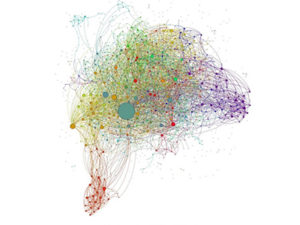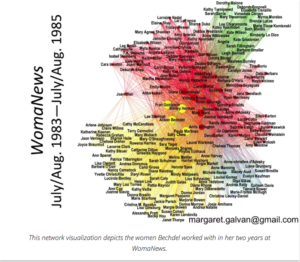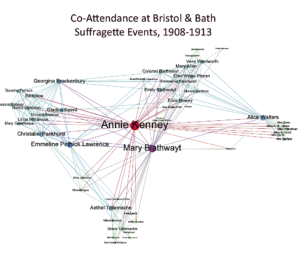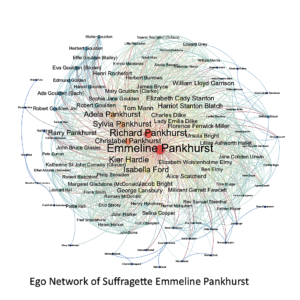
Ego Network of British Suffragette Emmeline Pankhurst
July 17, 2018 - All
Introduction
My Gephi visualization is based on relational data on the British suffrage movement and, in particular, focuses on the network of suffragette Emmeline Pankhurst (née Goulden, 1858-1928). Born to activist parents, Pankhurst used political agitation and militancy to advance the vote to all women in the UK. Her home (an interesting parallel to contemporary, online social networks) was a center of political activism that, according to Pankhurst herself, hosted “socialists, Fabians, anarchist, suffragists, free thinkers, radicals, and humanitarians of all schools.” University of Manchester sociologist Gemma Edwards compiled the dataset I used in my visualization. Edwards collected data on Pankhurst—as well as other suffrage events, militant acts, co-visitations, and co-attendances—from a historical archive of letters, speeches, newspaper articles, and autobiographies. Edwards then used Pajek (an early visualization tool) to create visualizations for a series of academic articles on secrecy-efficiency and tactical militancy in the suffragette movement. In these articles, Edwards and her coauthors argue that the suffragette network eventually becomes less dense and more decentered as the movement, according to Edwards, developed a need for covertness, militancy, and secrecy over time. Edwards’ position, and that of her co-authors, is convincing though not unproblematic. High levels of contact and interconnectedness are undeniably responsible for establishing the movement’s internal solidarity.
Inspirations
A visualization titled “Visualizing the Networks of Bicycling Groups for, of, and by Women in Philadelphia and New York City” by Molly Seegers (a former Pratt student) was particularly inspiring. As stated on the Visual Complexity website, this representation raises awareness about women who choose to ride bikes in urban areas and was created using Facebook to analyze how two bicycling groups differ in terms of density and group interaction. I was drawn to this visualization because it brings attention to an important issue—how women choose to navigate and travel together. Furthermore, it implicitly advances the discourse on how women circumnavigate spaces often restricted and bounded by physical and social barriers, which can be overcome through alliances and community building.

The visualizations of Margaret Galvan were also particularly influential for me. Her visualization “Mapping and Networking Alison Bechdel to Grassroots Periodical Culture, 1983-2008” charts cartoonist Alison Bechdel (Fun Home) connections to other women working on the same periodical as her when she worked at WomaNews (1983-1985), a radical feminist newspaper formally based out of Gainesville, Fl (now in NY). This was interesting to me because it focuses on Bechdel’s formative years and provides insight into the women Bechdel worked with while writing her Dykes to Watch Out For (DTWOF) comic series.

Methods
The Suffragette dataset contained several csv files, all in matrix form. To normalize the data, I used a concatenate formula in Google Sheets that combined the row heading, column heading, and cell value together if the cell had a value greater than 1. I used the concatenate function for all non-header cells to get a chained value (i.e. Target, Source, Weight). I then imported this spreadsheet into OpenRefine, transposed all columns into rows, split cells with multiple values into their own columns, and used a GREL expression to find and remove all self-references. I then loaded the clean data into Gephi and created different visualizations with the various datasets.
Findings
One of my first visualizations used the co-attendance of Bristol and Bath events data. It was a smaller dataset, which allowed me to experiment with running different statistics and layouts. What was particularly striking during experimenting with different files from the suffragette dataset was the amount of highly centralized and often dense networks. Star patterns, which can denote highly interconnected nodes, were evident in most of the suffragette data that I analyzed in Gephi. My main visualization, the ego network of Emmeline Pankhurst, allows insight into her inner network and shows connects to people like Elizabeth Cady Stanton, and Stanton’s daughter Harriot Stanton Blatch, as well as William Morris and William Lloyd Garrison. The visualization also shows the connections between Pankhurst’s marital family and children (center) as well as her natal family (the Goulden family), which can be found on the upper left part of the visualization.


Future Directions
I really liked working in Gephi and was impressed with all it can do. Network data is something that I am new to, but certainly believe that it can tell us a lot about subject-to-subject and subject-to-object relationships and how they look from a bird’s eye perspective. I would continue working in Gephi and experiment with different versions of the ego network, including taking out or moving the center node, to see what other relationships are at play.
The post Ego Network of British Suffragette Emmeline Pankhurst appeared first on Information Visualization.